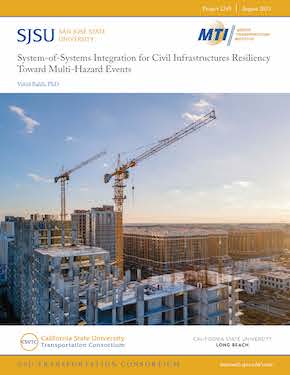- 408-924-7560
- mineta-institute@sjsu.edu
- Donate
System-of-Systems Integration for Civil Infrastructures Resiliency Toward Multi-Hazard Events
Civil infrastructure systems—facilities that supply principal services, such as electricity, water, transportation, etc., to a community—are the backbone of modern society. These systems are frequently subject to multi-hazard events, such as earthquakes. The poor resiliency of these infrastructures results in many human casualties and significant economic losses every year. An outline of a holistic view that considers how different civil infrastructure systems operate independently and how they interact and communicate with each other is required to have a resilient infrastructure system. More specifically a systems engineering approach is required to enable infrastructure to remain resilient in the case of extreme events, including natural disasters. To address these challenges, this research builds on the proposal that the infrastructure systems be equipped with state-of-the-art sensor networks that continuously record the condition and performance of the infrastructure. The sensor data from each infrastructure are then transferred to a data analysis system component that employs artificial intelligence techniques to constantly analyze the infrastructure’s resiliency and energy efficiency performance. This research models the resilient infrastructure problem as a System of Systems (SoS) comprised of the abovementioned components. It explores system integration and operability challenges and proposes solutions to meet the requirements of the SoS. An integration ontology, as well as a data-centric architecture, is developed to enable infrastructure resiliency toward multi-hazard events. The Federal Emergency Management Agency (FEMA), and infrastructure managers, such as Departments of Transportation (DOTs) and the Federal Highway Administration (FHWA), can learn from and integrate these solutions to make civil infrastructure systems more resilient for all.
VAHID BALALI, PHD
Dr. Balali is the principal investigator and an Associate Professor in the Department of Civil Engineering and Construction Engineering Management at California State University Long Beach. Dr. Balali’s research focuses on visual data sensing and analytics, virtual design and construction for civil infrastructure and interoperable system integration, and smart cities in transportation for sustainable decision-making. Dr. Balali is a recipient of the 2020 Early Academic Career Excellence Award from California State University Long Beach. He was also selected as one of the Top 40 under 40 by the Consulting-Specifying-Engineer for the year 2017 and the top young professional in California by the Engineering News-Record for the year 2016. He received the 2014 second-best poster award from the Construction Research Congress, as well as the 2013 CMAA national capital chapter scholarship award. He is currently an associate member of ASCE and CMAA, a committee member of the ASCE Data Sensing and Analysis and ASCE Visual Information Modeling and Simulation committees, and a friend member of relevant TRB committees. He is also serving as a reviewer of several top journals. He is actively collaborating with industrial partners and is involved in professional and outreach activities.
-
Contact Us
San José State University One Washington Square, San Jose, CA 95192 Phone: 408-924-7560 Email: mineta-institute@sjsu.edu






